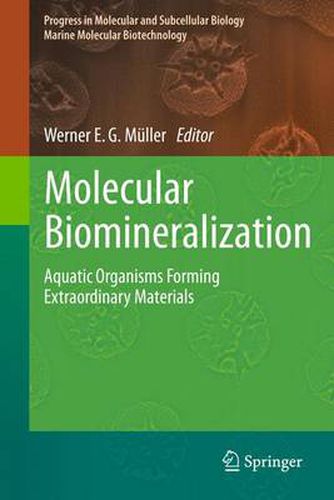Readings Newsletter
Become a Readings Member to make your shopping experience even easier.
Sign in or sign up for free!






This title is printed to order. This book may have been self-published. If so, we cannot guarantee the quality of the content. In the main most books will have gone through the editing process however some may not. We therefore suggest that you be aware of this before ordering this book. If in doubt check either the author or publisher’s details as we are unable to accept any returns unless they are faulty. Please contact us if you have any questions.
The concept of ‘biomineralization’ signifies mineralization processes that take place in close association with organic molecules or matrices. The awareness that mineral formation can be guided by organic molecules notably contributed to the understanding of the formation of the inorganic skeletons of living organisms. Modern electron microscopic and spectroscopic analyses have successfully demonstrated the participation of biological systems in several mineralization processes, and prominent examples include the formation of bio-silica in diatoms and sponges. This insight has already made the application of recombinant technology for the production of valuable inorganic polymers, such as bio-silica, possible. This polymer can be formed by silicatein under conditions that cannot be matched by chemical means. Similarly, the efforts described in this book have elucidated that certain organisms, bacteria in deep-sea polymetallic nodules and coccoliths in seamount crusts, are involved in the deposition of marine minerals. Strategies have already been developed to utilize such microorganisms for the biosynthesis and bioleaching of marine deposits. Moreover, studies reveal that bio-polymers enhance the hydroxyapatite formation of bone-forming cells and alter the expression of important regulators of bone resorption, suggesting a potential for bone regeneration and treatment / prevention of osteoporosis.
$9.00 standard shipping within Australia
FREE standard shipping within Australia for orders over $100.00
Express & International shipping calculated at checkout
This title is printed to order. This book may have been self-published. If so, we cannot guarantee the quality of the content. In the main most books will have gone through the editing process however some may not. We therefore suggest that you be aware of this before ordering this book. If in doubt check either the author or publisher’s details as we are unable to accept any returns unless they are faulty. Please contact us if you have any questions.
The concept of ‘biomineralization’ signifies mineralization processes that take place in close association with organic molecules or matrices. The awareness that mineral formation can be guided by organic molecules notably contributed to the understanding of the formation of the inorganic skeletons of living organisms. Modern electron microscopic and spectroscopic analyses have successfully demonstrated the participation of biological systems in several mineralization processes, and prominent examples include the formation of bio-silica in diatoms and sponges. This insight has already made the application of recombinant technology for the production of valuable inorganic polymers, such as bio-silica, possible. This polymer can be formed by silicatein under conditions that cannot be matched by chemical means. Similarly, the efforts described in this book have elucidated that certain organisms, bacteria in deep-sea polymetallic nodules and coccoliths in seamount crusts, are involved in the deposition of marine minerals. Strategies have already been developed to utilize such microorganisms for the biosynthesis and bioleaching of marine deposits. Moreover, studies reveal that bio-polymers enhance the hydroxyapatite formation of bone-forming cells and alter the expression of important regulators of bone resorption, suggesting a potential for bone regeneration and treatment / prevention of osteoporosis.